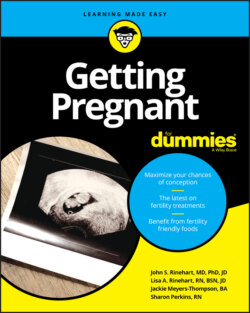Читать книгу Getting Pregnant For Dummies - Sharon Perkins - Страница 121
Facing Secondary Infertility
ОглавлениеDefining secondary infertility is not as straightforward as it may seem. Also, the term secondary infertility can be applied to a number of different situations. The Department of Health and Human Services (HHS) of the federal government defines secondary infertility as “infertility in a woman who has had one or more pregnancies, but cannot become pregnant again.”
Secondary infertility can occur whether the first conception was difficult or easy. It can be due to female issues, male issues, or a combination of both. One problem with the definitions is just what is meant by pregnancy. Does pregnancy mean a rise in the HCG shortly after a missed period? Does pregnancy include first trimester losses? Does pregnancy mean having a normal, healthy child at term? Considering that the purpose of the exercise is to have a full-term, live birth, it would seem that the most appropriate definition of pregnancy would be just that — a pregnancy that ended in the delivery at term of a healthy child.
The situation is complicated by the history of the previous pregnancy. Was the pregnancy conceived within a normal time frame and thus the couple were considered to have normal fertility? Or was the pregnancy conceived only after a diagnosis of infertility was made and the pregnancy was a result of treatment? The history helps determine what course of action is most appropriate to try for the next pregnancy.
For people who conceived spontaneously within six months to a year of trying, the diagnosis of infertility is made if they have been trying for six months to a year for another pregnancy and they have not achieved a pregnancy. After all, infertility is infertility, whether you call it primary or secondary. The significance of this is that once the term infertility is applied, the course of action is the same whether it is primary or secondary: use diagnostic tools to make a diagnosis. However, if the couple had the diagnosis of infertility for the successful pregnancy, then the course of action is determined by that diagnosis. It is not always necessary to reinvent the wheel! Other problems may have arisen in the meantime, but many problems will persist. The approach is to make sure nothing else has changed and then apply the previous diagnosis to determine what the best course of action will be.
For example, if there is a severe male factor in a young couple and it took IVF with ICSI to achieve a pregnancy, it most likely will require the same process for another child. If the diagnosis was polycystic ovarian syndrome, then it may actually be more difficult to conceive again. Possible reasons for this are that age may play a role, but many women gain weight when pregnant and it is difficult to lose this weight. Increased weight may make the PCOS more difficult to treat.
Frequently, couples seek consultation because of secondary infertility, and they feel they are unique and alone … this only happens to them. They start to question themselves, and this can lead to a feeling of isolation and guilt or of not being as good as someone else. If you find yourself in this bad head space, take note: Secondary infertility is common! The actual number of people experiencing secondary infertility is hard to determine, but estimates indicate that at least 30 percent of couples seeking help for infertility have secondary infertility.
Whatever the exact nature of the definition, few disagree that secondary infertility, whether an adjunct to primary infertility or a new challenge all its own, can be a confounding and painful experience that can prevent many from creating the complete family of their dreams.
